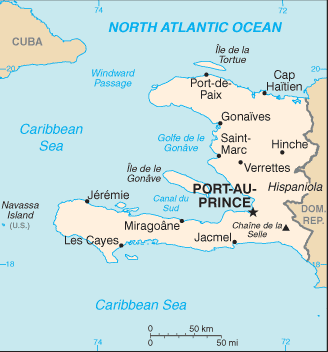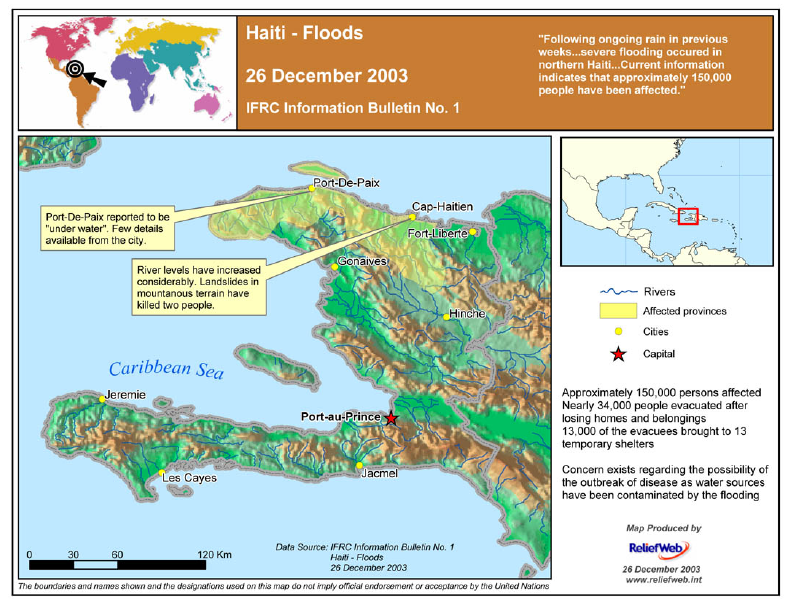
1. Abstract
Haiti once a brilliant star in a foreign empire is now the poorest of the Western
hemisphere nations. Through a legacy of colonialism and de facto colonialism
the land of Haiti steadily degraded to where the rock could be seen beneath
the soil. Where 98% of the forest had been destroyed more topsoil is taken out
to sea every year. At the same time an increase in sea surface temperature has
exacerbated the situation by increasing the destruction of storms every year.
the last four years saw grave destruction for the people of Haiti. Mudslides,
floods, wind damage and disease have left wanting. The situation has made many
have to decide to leave the country. With their homes destroyed they leave to
search for a better life. They are environmental refugees. They are forced into
bad areas due to economic and political persecution where their environment
is unable to sustain human activity. The destinations Haitians move to mostly
are the US, Canada and other Caribbean Islands including the Dominican Republic,
the Bahamas and Cuba. One finds the conflict with the immigration fo the Haitians
to these new environments. The conflict arises because they do not assimilate,
they retain their heritage and their national pride. They have become a transnational
entity. There is a possibility of new conflicts in the field of transnationalism
and environmental refugees, where the political and the social and separated,
the people remain loyal to the nation, but not to the state.
2. Description
Deforestation and the Fragile Haitian Ecology
Haiti was the jewel of the French Empire during the 18th century,
treasured for its lush forests. Times have changed however and after two centuries
as an independent state forest cover is now less than 2% of Haiti's land. The
remaining forest is being cut down at a rate of 4% per year. Deforestation
has left Haiti with a soil erosion problem made worse by hurricanes and severe
storms
which lead to floods and mud slides caused by steep slopes. The United Nations
estimates 50 percent of the country's topsoil has been run off into the ocean,
making it unreclaimable for farmland. Haiti has experienced high rates of population
growth at 2.3% in 2006. And with 60% of the population engaged in agricultural
production
the decrease in productivity has led to a decrease in incomes and increased
poverty [1] .
With the loss of topsoil a disturbing trend arose in Haitian
economic geography, the move from subsistence farming to the harvesting of
trees for fuelwood and production of charcoal. The farmland was no longer productive
so people switched to harvesting the forests, causing more destruction of natural
watersheds and increasing the soil erosion. As branches and trees have become
less and less available Haitians have begun using roots, twigs and stumps as
fuel. The removal of stumps and roots ensures trees will not grow again
and leaves the topsoil exposed. The use of biomass is the biggest source of
energy for Haiti. The charcoal and fuelwood industries are very important to
the people's livelihood, but the practice is not sustainable [2].
In the mean time, fuelwood meets 70% of energy needs. The
emergence of an energy industry began in the 1940's and 50's in Haiti, so it
is a relatively recent phenomenom. The use of the forests has spread in a matter
of ten years. The image below shows the spread of charcoal production between
the years 1980-1990. The increase in the fuel industry has exacerbated an already
fragile environment. Crucial watersheds are destroyed leaving the land naked
to destruction by storms which are becoming stronger every year.

Since so many people depend on agriculture for subsistence it
is important for the security of the country. One-third, approximately 28%
according to the CIA, of the land is considered suitable for farming. Much
of the land being farmed is considered unarable. The recent refugees coming
from are Haiti are not political refugees, but are environmental refugees.
The refugees arriving into the United States are being pushed by environmental
degradation, not pulled by economic opportunity. An estimated 1.3 million people
or 20% of the population have left the country, and 300,000 of them have left
for the United States. These refugees are a new category in the 21st century,
the environmental refugee. A measure of stability has reached Haiti and the
violence subsides; however, the refugees,
known as "boat people", continue to arrive on the shores of the United
States, citing the reason why they are not merely political dissidents, but environmental
victims [4].
The chain of events has contributed to Haiti being the poorest
nation in the Western Hemisphere: First there was deforestation caused by
large
the building of large plantations. Increased deforestation occurs because of
the emergence of a fuel industry. Biomass has always been the primary source
of fuel for Haitians. The environment is very steep, so run off increases;
furthermnore, the increase in rain and severe storms has led to more
run off and mroe soil erosion. Then the land becomes less productive, so people
look to the fuel industry to supplement their income. This is not a sustainable
system of living. The trees will be gone someday.
French Link to Deforestation
|
Haitians led the only successful slave rebellion in the New World. They overthrew
the French authorities and became second Republic in the hemisphere and
the first Black Republic. Led by Toussaint L'Ouverture, the blacks felt
spurned by the French because they did not apply in the French slogan
of Liberte, Egalite and Fraternite.
Upon gaining independence in 1804, the Haitians were still not safe.
French warships still caused anxiety about Haiti's security especially
their threat of reinstituting slavery. The former slaves held for 21 years
until they reached an agreement with France in 1825 to pay them for their
independence. Upon the agreement they would finally be recognized as a
member of the international community as well. The reparations in which
the Haitians were made to pay were enormous and sometimes were 80% of
the country's revenue. It is estimated $21 billion dollars in current
income. So almost all resources were funnelled to paying the debt to France
for more than a century. The Haitians cut down forests selling the tropical
hard wood for the production of French furniture. The debt was finally
paid off in 1947 [21]. Forestry continued with the trees
being made into charcoal instead of furniture. The French aided in creating
a culture of deforestation that has left the land degraded, more vulnerable
to natural disasters than any other Caribbean nation. |
 |
Carbon Dioxide Emissions and Hurricane Intensity:
The Causal Link
Studies linking the frequency of hurricanes and global climate
change has been rebuked. Multi-decadal fluctuations and the phenomena such
as El Nino are blamed for the difference in frequency of hurricanes over time.
The 50's and 60's saw an upswing in the amount of hurricanes, while from the
70's to the 90's there was a decrease in hurricane activity. The current decade
is but another shift in the frequency of hurricanes. The 2005 season was the
most intense hurricane season on record. There was a record 27 named storms
and 15 hurricanes. Four of the 15 hurricanes were category 5 storms. This season
also included the most intense storm on record, Hurricane Wilma [7].
The intensity of hurricanes is what is most disconcerting and Kerry
Emanuel of MIT has found proof of a link between increased sea surface
temperatures and the intensity of hurricanes. The Atlantic ocean acts as
an engine for stronger
storms coming off the coast of Africa. One finds the intensity of the storm
to be the most important factor when deciphering how global warming will
affect
our lives. The intensity has been shown to create the costliest storms in the
last ten years. The frequency of storms effects the agriculture and way of
life, but it does not create the destruction in which an intense storm can
destroy
capital and kill people. The best example would be of the category
five hurricanes which hit New Orleans consecutively, in Katrina and Rita.
Emanueal finds a correlation between increased Sea Surface
Temperature and the Power Dissipation Index. The spreadsheet containing his
data is contained in this linkunder excel spreadsheet: SST
vs. PDI [8].
The result of storms becoming stronger is more damage. They will
also last longer because as the intensity rises the storm takes longer to gain
strength as well as lose strength. As said earlier the ocean acts as an engine
for tropical storms and the emission of greenhouse gases into the atmosphere
has heated up the oceans. Thus the warmer the ocean is, the more powerful storms
there will be.
Environmental Refugees: Hurricane Katrina 2005
The refugees arriving from Haiti are environmental refugees. They are victims of global warming because they suffer from the effects of stronger hurricanes.
Norman Myers opened people's eyes to the new refugee situation
in the world at the 13th Economic Forum in Prague. He expressed a need to form
a
new paradigm
for refugee status. There were people in the world who were forced to move
from their homes because of either drought, desertification, soil etc. They
could
not eek out a meager living any longer, so they were forced to migrate. In
1995, there numbered 25 million environmental refugees with the amount climbing
fast.
Most of the refugees are from developing countries. The main crossing points
are between Latin America, specifically, Mexico and the Caribbean ,and the
United
States and Africa, specifically the Sahel region and Europe. Where the developed
countries must be concerned with is the cost of assimilating them into their
countires or repatriating the refugees to their former countries. Most nations
have restricted immigration in recent years bringing more strife to environmental
refugees and have decreased foreign aid. He ends with a call to plant trees
to improve the environment [9]. Developed countries are
responsible for the plight of refugees. They have created untenable situations
through carbon
emissions creating global climate change. The environment need to be
recognized as a legitimate reason for emigration. The plight of developing
nations
with fragile environments is greater than developed nations; therefore, the
damage inflicted by extreme events is much worse in a place like Haiti. Environmental
refugees are sometimes not allowed to stay in foreign lands because their situation
does not warrant refugee status. Andrew Simms of the New Economics Foundation
in London, England says the term "persecution" should be applied
to environmental persecution whereby people are "forced to live in worsening
poverty on land that without warning could flood, or turn to dust."
"Is it right that while some states
are more responsible for creating
problems like global climate
change, all states should bear equal
responsibility to deal with its
displaced people?"
Andrew Simms, New Economics Foundation
|
The best and most appropriate example of environmental persecution occurred
in the United States during the 2005 hurricane season. Hurricane Katrina
was an excellent example of how the global increase in ocean temperature
had strenghtened hurricanes. In fact, two category 5 hurricanes landed
on New Orleans, Katrina and Rita. Most of New Orleans is below sea level.
A series of levees, canals and pumps are used to control the flooding
of the city during heavy rainfall. The levees were predicted to not be
high enough to protect the city. The storm surge was predicted to be 28
ft., the levees were made to protect against a category 3 hurricane. The
authorities knew there would be an enormous loss of life, so they called
for an evacuation of the city; however, 25-30% of New Orleaneans did not
possess vehicles. And municipal officials were not prepared for the disaster
leaving many stranded. So, many New Orleans residents who were poor, infirm,
elderly, or disabled were left to fend for themselves [11].
In the end, there were 1.5 million people displaced, 200,000 homes destroyed
and 81,000 businesses affected. Forty-four percent of the people who migrated
to Houston said they would not return to New Orleans. This is the first
large group of environmental refugees in the US. It was costly politically
because it enlightened many to the economic and social inequalities which
have been gaining in American society [12].
The people affected the most were the African-American community for
they made up 70% of New Orleans population. The devastation was a reminder
of the legacy of the economic persecution blacks have faced. They had
been hurded into the lowest sections of the city whereby they would be
hurt most if the levees were to break. The death toll was purported to
be around 1,300, but more was predicted because of the amount of missing
persons reports [13]. Moreover, a large refugee community exists, 240,000
refugees went to Houston, Texas or other close cities while another 60,000
have gone to places more than 750 miles away. The US Census put the population
at 484,674 in 2000, but by January 2006 the number had decreased to approximately
200,000 as much of the population was forced to relocate due to the destruction
[11]. |
The convenience of not naming environmental refugees releases states from
any responsibility for their situation. The people of New Orleans were environmentally
persecuted because of their class. They did not have adequate safety from natural
disasters. Where much of the inner city was populated blacks and much of
the suburbs were populated by whites. The de facto segregation underscores
a legacy of racism that persists until today. The image below shows the where
the highest waters were in the city. This correlates with the districts heavily
populated by blacks. On pages 14-15 of "
Mapping
Hurricane Katrina with GIS" one can find the information for the population
of blacks and of whites.
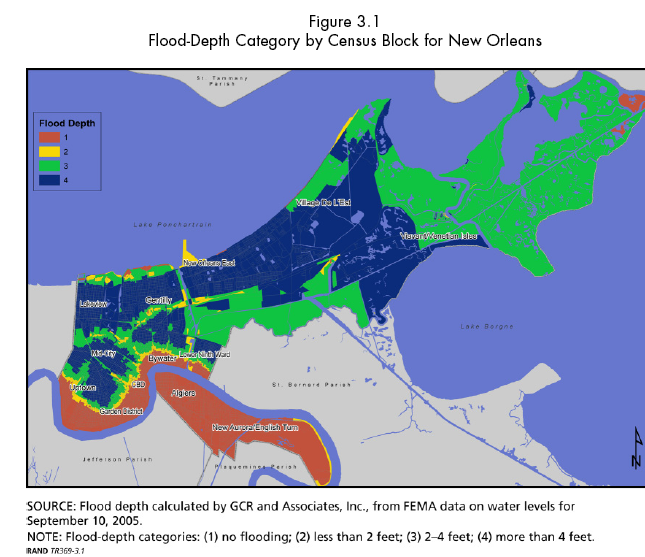
The people
of New Orleans become some of the first US environmental refugees of the 21st
century. It was the state's responsibility to protect the people and it failed
miserably.
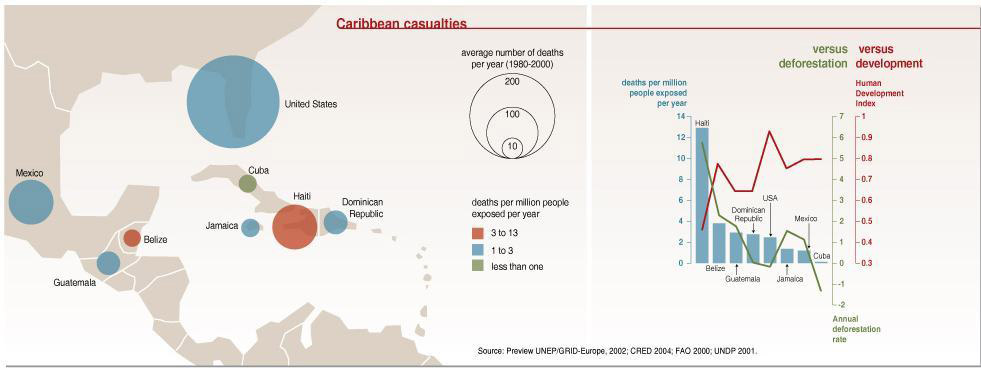
Haiti disproportionately
suffers the affects of disasters. There is a direct link between casualties
and deforestation which provides direction for future development policy in
developing nations and specifically in Haiti.
3. Duration
The conflict will be generational as the effects of global climate change are not fully known.
4. Location : North America / Caribbean
The conflicts will be within Haiti with internally displaced persons, and between Haitians and foreign nations specifically the Dominican Republic, Canada and the United States.
5. Actors -
United States Government, Haitian Government, Haitian peasants, Haitian refugees and peasants,
Haitian-American Lobby

6. Type of Environmental Problem- Hurricanes, Flooding
|
December 2003
Floods hit the Northern part of Haiti in December of 2003. 150,000 people
were affected by the flooding. The city of Port-de-Paix was left underwater.
The yellow shaded areas are the areas affected most. |
|
Hurricane Jeanne: September 2004
An
example of a current distater displacing many people was the 2004 hurricane
season. Specifically Hurricane Jeanne hit Haiti directly causing mudslides
and floods. What is a nuisance for a developed nation becomes a catastrophe
to a developing nation. The city of Gonaives
was devastated by Hurricane Jeanne. The high price of oil and deforestation
makes Haiti especially susceptible to natural distaters. The waters rose
to 4 meters or more than 12 feet in the center of Gonaives, forcing
people
to seek safety on rooftops [14]. Three thousand lives
were claimed by the floods and 200,000 people became homeless. What
ensued
was a hunger crisis, whereby some did not eat for three weeks after the
storm [15]. |
Hurricane Dennis: July 2005
The following year hurricane
Dennis hit Haiti as well as other Caribbean nations. This time southern
Haiti was effected including the capital Port-au-Prince
[16]. Twenty -nine people were killed and nearly a hundred homes
were destroyed leaving 500 people displaced. These numbers pale in comparison
to the previous year, but still create instability among an already chaotic
situation. |
|
November 2006
The floods of 2006 affected three principle areas, Northwest, Grande-Anse,
and Nippes, Haiti. Seven people died and 317 homes were destroyed. The
yearly destruction of powerful storms takes a toll on the people of Haiti.
|
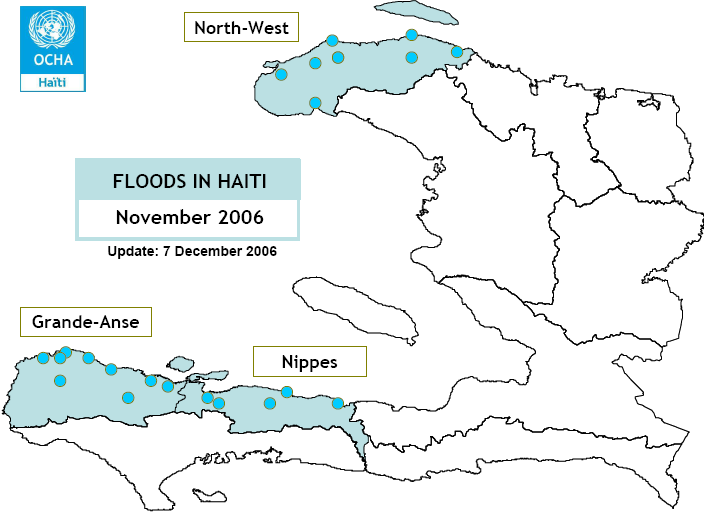 |
There is no coincidence that the most affected regions
have been the North West province and Grand-Anse for they produce the most charcoal
according to figure 1.
7. Type of Habitat- Tropical
The land of Haiti is mostly mountainous. With a lack of plains for arable
farming the colonizers cleared the forests to build large plantations. Most
of the topsoil
for farming washes into the ocean. The deforestation is a cause of the soil
erosion which leads to desertification. This is experienced most in the Northwest
of the peninsula where the poorest reside [6].
8. Act and Harm Sites
The extreme events will take place in Haiti. The environmental refugees will
look countries like the Dominican Republic, the United States and Canada.
They have and continue to find conflict and resistance.
III. Conflict
Aspects
9. Type of Conflict- international war
The conflict will resound between Haitian migrants and the US, Canadian, and
Dominican government officials. As Haiti's environment becomes more degraded
and the assistance continues to be neglible, Haitians will continue to migrate.
The situation will be furthered by the powerful storms which yearly devastate
the fragile economic, social and political life of Haiti. The immigration policies
of each country, specifically the United States, will be an important factor
in the coming crisis.
US immigration policy vis-a-vis Haiti
Carter Administration
Up until 1980, the US immigration policy was directed by a Cold War paradigm.
Ninety-five percent of the refugees admitted into the country were from Communist
countries, others asking for asylum were denied [17]. The
Mariel Boatlift, whereby 130,00 Cubans and 30,000 Haitians set off from Mariel
Harbor in Cuba for Miami. An act of defiance by Fidel Castro, the
Boatlift was mostly thought of as an attempt for Fidel Castro to ship all dissidents,
criminals, homosexuals and other groups he did not desire to the United States.
The Haitians were let in by the Cuban-Haitian entrants status program . The
Attorney General was given the power to admit the Mariel Boatlift refugees [18].
They considered most Haitians to be economic migrants, but were compassionate
to their situation.
|
Reagan Administration
The Reagan administration switched policy positions and signed an agreement
with the dictator of Haiti, Jean-Claude "Baby-Doc" Duvalier
for the interdiction of Haitian ships. The Coast Guard was allowed
to
board Haitian ships and interrogate the passengers. If they were found
to be undocumented Haitians they would be returned to Haiti. Between
1981-1990
22,940 Haitians were interdicted. The Immigration and Narualization Service
(INS) decided only 11 were worthy of asylum. A new "Haiti program"
was started as well with the agreement. The program's goal was to expedite
the process of Haitian asylum seekers. They were denied access to lawyers
to stop any claims for asylum. Any Haitian who made it to shore would
be put in one of the different detention centers in Lake Placid, Big
Spring,Texas,
Fort Allen in Puerto Rico or Krome, Florida [19].
Looking at the graph, the amount of interdictions should correspond with
roughly the amount of Haitians migrating. The spikes are responses to
actions on the ground. Which Jean Bertrand Aristide was elected the amount
of interdictions decreased as stability was brought to the country. The
1991 coup spikes interdictions in 1992. There is another spike in 1993
as economic sanctions are imposed on Haiti's military government. A few
years of stability mean interdictions decrease with the administration
of Rene Preval. They go to the lowest in ten years in 1997. The interdictions
spike once again during the 1998 Hurricane Georges natural disaster. They
start to increase in 2003-2004 due to the coup and then Hurricane Jeanne.
|
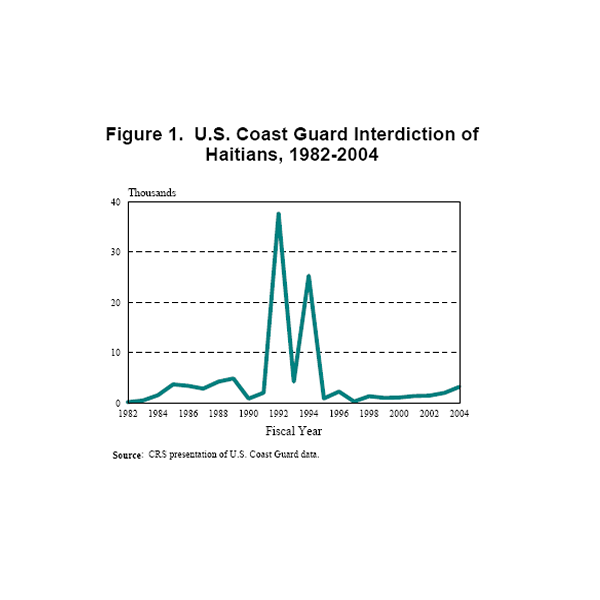 |
First Bush Administration
President evolved the policy of interdiction by not demanding interviews of
the refugees on the ship. They could be repatriated without deciphering if
they
had a credible fear of return [17]. He continued Reagan's
policies but found some obstacles as the Supreme Court found it unconstitutional
to deport the Haitians without due process. The executive decision was to transfer
the refugees to Guantanamo Bay and interview them to see if they were being
politically persecuted [19]. This was called asylum, for
the need to be in accordance with international law, but the truth of the
matter
was quite different. Two thousand Haitians were detained in the Krome detention
facility for more than a year without due process.
Clinton Administration
Even in the crises of 1992 and 1994, where we find a notable spike in Haitian
emigration. The Haitian army began a reign of terror among the citizenry
killing
crucial backers of Jean Bertrand Aristide. The violence was led by a general,
Raul Cedras who was the leader of the 1991 coup. He was found to have attended
the
School of the Americas which is a training ground for soldiers from foreign
countries run by the CIA. He was also linked to the CIA during the coup, sparking
accusations of collusion between the Haitian military and the United States
in the overthrow of Aristide [20].
Through pressure groups, limited
reform
did
occur in the Clinton adminstration. In1994, an in-country asylum processing
station was set up in the capital, therefore eliminating the sea as an obstacle
for obtaining asylum [17]. Also, the Haitian Immigration
Fairness Act was written into law in 1998, whereby those Haitians living in
the United
States since 1995 could apply to be permanent legal residents
[18].
| Policies under
Second Bush Adminstration
- State Department supports policies of return because it sees no history
of repression in Haiti.
- Asylum seekers were to be detained while their claim was processed,
this policy was exclusive to Haitians.
- John Ashcroft decided immigrants could be jailed if they constituted
a national security risk [18]. The national security
risk was taking away resources from the Coast Guard from fighting the
War on Terror.
-The policy of interdictions at sea continues unabated.
|
Climate Justice
The Democratic administrations of Jimmy Carter and Bill Clinton saw a loosening
of regulations and injustice concerning Haitian environmental refugees. The
Republican administrations beginning with Ronald Reagan's deal with Baby Doc
Duvalier to allow interdictions began a trying time for Haitian migrants.
George
H.W. Bush began keeping migrants in the Guantanamo Bay detention facility as
well as other holding centers throughout the United States. And finally George
W. Bush has made the policy a national security issue. Interdictions take resources
away from the Coast Guard from fighting the War on Terror and Haitians should
be deterred as much as possible from making the boat trip to the Florida shores.
There is a forseeable threat of conflict between the country of Haiti and
the
United States government. It is what some have come to call climate
justice, the disasters which usually affect Haiti every five to ten
years are becoming more frequent and much deadlier. When Haiti asks the United
States to pay for the damages done to its infrastructure after one of these
disasters the response will most likely be hostile.
Transnationalism
Recent developments in communications and society have strenghtened
the ties between emigrants and their homes. The recent idea of climate
justice and success of peoples who have left their poverty stricken homes point
to the fact some of the problems may be environmental. Instead of embracing
a new state, Haitians have formed a transnational state whereby remittances
are equal to a quarter of Haiti's GDP, $1.65 billion in 2006 [21].
Remittances are the source of many Haitians subsistence. About 1.3 million
Haitian live outside with the United States being the most common destination.
Big centers of Haitian settlement are in New York and Miami. Haitians especially
come to America with an already developed identity. Known as the first Black
Republic in the world they are proud of their heritage. They have found ways
to differentiate themselves from African-Americans, the groups with whom most
would identify them. The population has found a way to identify as being American
and Haitian [22]. The issue has been small, but if a horrific
event occurs, it will spark the energy needed to create change in the immigration
policy. The Haitian diaspora has not been able to exact any significant change
in US policy so far.
10. Level of Conflict- threat
The conflict level is threat. This does not include the people dying in hurricanes
or mudslides. The oncoming conflict will be between Haitian refugees and
the United States as well as other developed nations. They will call for
climate justice.
11. Fatality Level of Dispute (military and civilian fatalities)
The deathtoll will be somewhere in the thousands as the Haitian "boat
people" attempt to travail across the Gulf of Mexico into the United States.

12. Environment-Conflict Link and Dynamics:
Causal Diagram
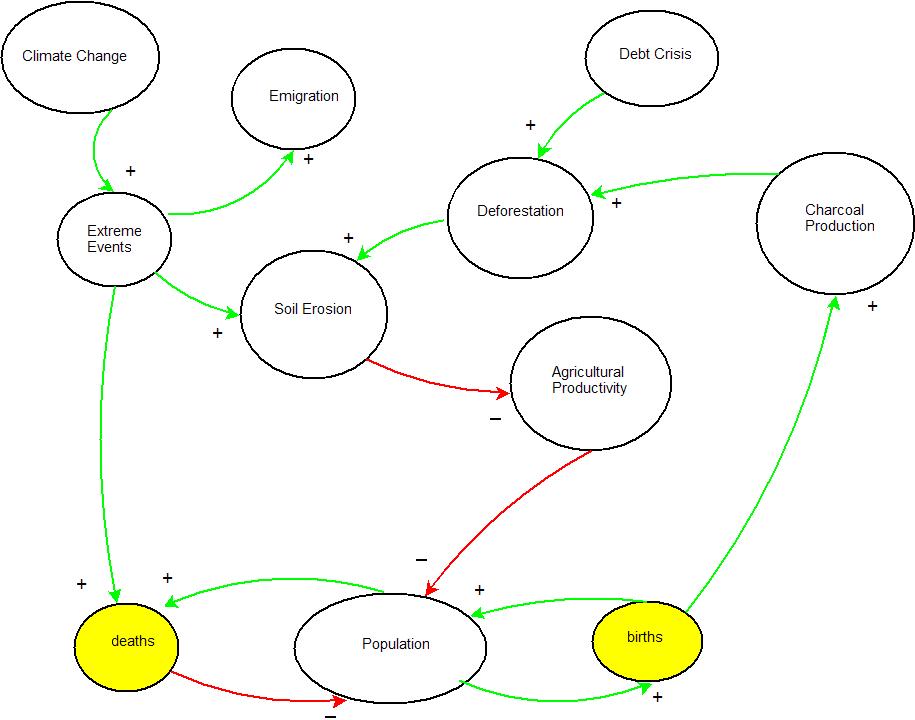
13. Level of Strategic Interest
Regional, with International Implications
The issue of climate justice and environmental refugees are becoming pivotal
subjects in the international arena. Countries of the Global South are looking
to the Indutrialized Nations to take responsibility for the current and future
changes in the environment.
14. Outcome of Dispute: Unknown
One predicts a disaster unless developed nations begin to
invest heavily in developing nations. Current amounts fall short of development
goals. US interdictions are illegal and should be stopped
immediately as well.
15. Related ICE and TED Cases
1. Haiti Deforestation
This case is the most similar case in the environment and conflict database.
This case acts as an expansion upon this original csase talking about the deprivation
of Haiti because of deforestation. It adds elements of colonialism, climate
change and US immigration policy.
2. Nicaragua-Honduras territorial dispute
We find resource scarcity in other areas of the Caribbean. If the whole area
is suffering from a lack of resources they should become more organized in specializing
in certain areas of production. A lot of information is mising from this case
which does not allow my analysis to go any further.
3. Haiti and Economic Sanctions
Economic sanctions seem have enhanced an already deteriorating situation in
Haiti. The United States is worried about Haitian immigration, but it increases
the amount of poverty and thus the amount of immigrants by putting sanctions
on the government. Economic sanctions should not be the answer.
4. Canadian Sovereignty and the Northwest Passage
This case is similar because it involves two North American countries. We see
how the relations between two countries can affect worldwide policy practices.
Immigration policy towards Haiti is watched by other Caribbean nations, and
the US is criticized because of an imprudent law.
5. Congo: Diamond Mining and Conflict
The Congo is a country which is a former colony like Haiti. It has experienced
great internal strife because of the conflict in Rwanda during the 90's. This
is important for US policy, with environmental conflict in other countries,
there is a likelihood they could spill over into the United States. The solution
would not be to deport however. They must look for other solutions, like assimilation
and processing stations in Haiti.
16. Relevant Websites and Literature
Works Cited
1. Homer-Dixon, Thomas F. "Environmental Scarcities and Violent Conflict: Evidence from Cases". nInternational Security . no.19,1 (Summer 1994) p.5-40
2. Baro, Mamadou. "Food Insecurity and Livelihood Systems in Northwest Haiti." Journal of Political Ecology. no.19 (2002) p.1-34
3. Lea, John Dale. "A Review of Literature on Charcoal in Haiti." South East Consortium for International Development USAID Haiti Productive Land Use Systems Project. Prosopis Wokshop (13-15 March 1996).
4. Myers, Norman.
"Environmental Refugees: A Growing Phenonmenom of the 21st Century."
Philosophical Transactions of the Royal Society: Biological Sciences .ano.357,
1420 (April 2002) 609-613 d
5. Philips, Anthony and Brian
Concannon Jr. "Economic Justice in Haiti Requires Debt Restitution".
IRC Americas Program. 7 Sept 2006. 20 March 2007.
< http://us.oneworld.net/external/?url=http%3A%2F%2Famericas.irc-online.org%2Fam%2F3494
>
6. White, Anderson. "Policy Lessons
from History and Natural Resource Projects in Rural Haiti". Working
Paper no. 17. USAID. (November 1994) 1-58.
7. Climate of 2005 Hurricane Season.
21 August 2006. 12 March 2007 (National Climatic Data Center) <
http://www.ncdc.noaa.gov/oa/climate/research/2005/hurricanes05.html >.
8. Emanuel, Kerry. "Increasing Destructiveness
of Tropical Cyclones Over the Past Thirty Years." Nature. no.436
(4 August 2005) 686-688.
9. Myers, Norman. "Environmental
Refugees: An Emergent Security Issue." 13th Economic Forum Prague 23-27
May 2005 . 22 May 2005.
10.Wilkinson, Ray. "Should Environmental Migrants be
considered Refugees?" Refugees no.127 (2002) p.12-13.
11. Andronache, Constantin et al. "Mapping Hurricane Katrina
with GIS." Boston College. < http://gis.esri.com/library/userconf/proc06/papers/papers/pap_2320.pdf>
12. Waugh, William L. "The Political Costs of Failure
in the Katrina and Rita Disasters." The Annals of the American Academy
of Politcal and Social Sciences. (2006) 604, 10-25.
13.Anonymous. "Death toll from Katrina likely higher
than 1,300." MSNBC . 10 Feb 2006. 13 March 2007. <http://www.msnbc.msn.com/id/11281267
>
14.Anonymous. "Haiti Floods- Hurricane Jeanne."
ActionAid. 18 Sept 2004. 15 March 2007
< http://www.actionaid.org.uk/1367/haiti_floods.html >
15. Kovats-Bernat, J. Christopher. "Factional Terror,
Militarism, and Civil War in Haiti: The View from Port-au-Prince 1994-2004."
Muhlenberg
College. < http://www.muhlenberg.edu/depts/soc-anth/faculty/publication-2005.pdf >
16. Anonymous. "Hurricane Dennis leaves trail of destruction
in Cuba and Haiti." Catholic Relief Services. 11 July 2005. 15 March
2005.
< www.crs.org/.../cuba/emergency response.cfm >.
17. Shellman, Stephen and Brandon Stewart. "Political
Persecution or Economic Deprivation: A Time Series Analysis of Haitian Exodus,
1990-2004".
18. Charles, Carolle. "Political Refugees or Economic
Migrants?: A New "Old" Debate within the Haitian Immigrant Communities
but with
Contestations and Divisions". Journal of American
Ethnic History . (Winter/Spring 2006) 190-208
19. Wasem, Ruth Ellen. " US immigration policy on Haitian
migrants". CRS report for Congress.
20. Dow, Mark. "Occupying and Obscuring Haiti".
New Politics . (Winter 1995) 5, no. 2 < http://www.wpunj.edu/newpol/issue18/dow18.htm
>
21. Anonymous. "Remittances to Haiti topped $1.65 billion in 2006, says IDB fund." Inter-American Development Bank . March 5, 2007.
< http://www.iadb.org/NEWS/articledetail.cfm?artid=3637&language=En >.
22. Glick Schiller, Nina and Georges E. Fouron. "Terrains of Blood and Nation: Haitian Transnational Social Field." Ethnic and Racial Studies. (March 1999) 22 no.2 p.340-366.
4/11/20073ntal Scarc s Violent Conflict: Evidence rom
Case
